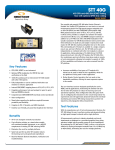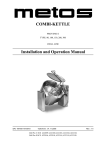Download paper - Neil Brown
Transcript
Alloy: Fast Generic Transformations for Haskell Neil C. C. Brown Adam T. Sampson Computing Laboratory, University of Kent, UK, CT2 7NF [email protected], [email protected] Abstract • We describe the basic algorithm, implementation and API of Alloy, a library for generic traversals and transformations built using Haskell type-classes (section 3). We later describe a further improvement to our approach (section 7). Data-type generic programming can be used to traverse and manipulate specific parts of large heterogeneously-typed tree structures, without the need for tedious boilerplate. Generic programming is often approached from a theoretical perspective, where the emphasis lies on the power of the representation rather than on efficiency. We describe use cases for a generic system derived from our work on a nanopass compiler, where efficiency is a real concern, and detail a new generics approach (Alloy) that we have developed in Haskell to allow our compiler passes to traverse the abstract syntax tree quickly. We benchmark our approach against several other Haskell generics approaches and statistically analyse the results, finding that Alloy is fastest on heterogeneously-typed trees. Categories and Subject Descriptors tional) Programming] General Terms Keywords 1. • We explain several real use cases of data-type generic program- ming in our compiler, and examine how to implement them efficiently (section 4). • We benchmark and statistically analyse the results of Alloy and existing generics approaches (sections 5, 6 and 6.5). The results show that Alloy is faster than existing approaches for traversing heterogeneously-typed trees (we conclude in section 8). 2. D.1.1 [Applicative (Func- Motivation We develop Tock, a compiler for imperative parallel languages such as occam-π (Welch and Barnes 2005), in Haskell. Tock is currently over 20,000 non-blank lines of Haskell code. Tock is a nanopass compiler (Sarkar et al. 2004), meaning that its design consists of many (currently around 40) small passes that operate on the Abstract Syntax Tree (AST) of the program, each performing one simple operation, for example: making names unique, or checking that variables declared constant are not modified. A pass that makes names unique must traverse the entire AST, operating on all names. A constant folding pass must traverse the entire AST, operating on all expressions. To avoid writing boilerplate for each traversal, we use generic programming. To ensure fast compilation of occam-π code, the 40 traversals of the tree must be as fast as possible. Our passes typically operate on one or two types, but the most complex passes (such as the type-checker) operate on up to nine types in one traversal, with complicated rules for when the traversal must descend further into the tree, and when it must not. Our AST currently consists of around 40 different algebraic data types, with around 170 constructors between them. If all the basic sub-types (lists, pairs, primitive types, etc) are also included, we have around 110 different types. We began by using the Scrap Your Boilerplate (SYB) library (Lämmel and Peyton Jones 2003), we found it was too slow for our purposes, leading us to first augment SYB, and then replace it altogether with Alloy. We require the following generics facilities: Languages, Performance Generic Programming, Haskell, Alloy Introduction Data-type generic programming concerns functions that depend on the structure of data-types, such as pretty-printing. A very common use is the automatic application of a function that operates on subelements of a larger type. This avoids the need for large amounts of systematic boilerplate code to traverse all the types not of interest to apply functions to the types that are of interest. Generic programming research has become popular over the last ten years, particularly in the functional programming language Haskell (for a review, see Rodriguez et al. 2008). The approaches mainly differ by theoretical approach or the use of different language features to achieve generic programming (including several language extensions for generic programming). Our interest in generic programming is pragmatic. We use generic programming in a compiler to eliminate boilerplate, and we require a straightforward API backed by a very fast generics approach (see section 2 for more detail of our requirements). We began by using a pre-existing generics system, but found that it was not fast enough for our needs. We thus developed our own generics library for Haskell, Alloy, that blends together features of several existing generics approaches into an efficient whole. Our contributions are as follows: • Monadic transformations. Most transformation functions must run in our compiler monad, so that they have access to the compiler’s state and can report errors. As we will see later, while we require the full power of monads for the compiler, our generics approach only requires the more general applicative functors (McBride and Paterson 2008). Permission to make digital or hard copies of all or part of this work for personal or classroom use is granted without fee provided that copies are not made or distributed for profit or commercial advantage and that copies bear this notice and the full citation on the first page. To copy otherwise, to republish, to post on servers or to redistribute to lists, requires prior specific permission and/or a fee. Haskell’09, September 3, 2009, Edinburgh, Scotland, UK. c 2009 ACM 978-1-60558-508-6/09/08. . . $5.00 Copyright • Multiple target types. Several passes – particularly those that walk the tree updating some internal state – need to operate upon multiple target types at once. 105 • Explicit descent. Some passes must be able to decide whether – and when – to descend into a subtree. A convenient way to do this is to provide a function like gmap or descend. (An alternative used by Strafunski (Lämmel and Visser 2002) is to define tree traversal strategies separately from the transformation functions, but in Tock this would mean duplicating decision logic in many cases, since traversal strategies are often pass-specific.) • High-level common operations. Most passes do not need explicit descent; we need helper functions like everywhere to apply simple depth-first transformations and checks to the tree. • No need to define instances by hand. Tock’s AST representa- tion is complex, and sometimes extended or refactored. Writing type class instances by hand would require a lot of effort (and be prone to mistakes); we must be able to generate them automatically, such as with an external tool. • Decent performance. Walking the entire tree for every pass is Figure 1. An illustration of the largest types in a tree. The shape of a node indicates its type. The shaded shapes are the largest instances when the types of interest are triangles and pentagons. unacceptably inefficient; each traversal should examine as few nodes as possible. • Library-level. We want it to be easy to distribute and build Tock. Therefore any generics approach that we use must be in the form of a library that uses existing Glasgow Haskell Compiler (GHC) features, so that it can be built with a standard distribution of GHC by our end-users. Ideally, we would depend only on extensions to the Haskell language that are likely to end up in the next Haskell standard, Haskell Prime. Our basic algorithm is to have a queued opset ready to be compared to the suspect type, and a descent opset ready to be applied to the suspect’s children if no exact match is found. We repeatedly take one operation from the queued opset, and compare it to the suspect type. There can be three possible results of this comparison: In section 4 we will detail several use cases that show examples of where we need these different features of generic programming. There are several features of generic programming in the literature that we do not require. We refer to them, where possible, by the names given in Rodriguez et al. (2008): 1. the suspect type matches the operation type, 2. the suspect type can contain the operation type, or 3. the suspect type cannot contain the operation type. • Multiple arguments: This is required by operations such as In case 1, the operation is applied and the result returned. No further work is done by the current call. In case 2, the operation is retained, by moving it onto the descent opset. In case 3, the operation is discarded. As an example, consider the following type: generic zipping, or generic equality. In Tock we always operate on a part of the AST and do not need this. • Constructor names: This is required by operations such as gshow. While Alloy could easily be extended to support this, we do not require this functionality in Tock. • Type-altering transformations: We need transformations of the form a -> a (and a -> m a), but we do not need type-altering transformations of the form a -> b. data Foo = FooInt Int Int | FooFloat Float • Extensibility: Several authors (Hinze 2004; Oliveira et al. Figure 2 demonstrates our opset being compared against the suspect type Foo. The operations on Float and Int are retained (because Foo can contain those types), whereas the operation on type String is discarded. Alloy is similar to several other approaches, such as Uniplate (Mitchell and Runciman 2007), SYB (Lämmel and Peyton Jones 2003) and Smash (Kiselyov 2006). The two key features of Alloy, intended to increase its efficiency, are that: We wish to apply transformations to everything of type Float , Int and String that might be contained in the suspect type Foo. 2007; Lämmel and Peyton Jones 2005) have identified the problem that once generic functions have been defined as a list of specific cases (also known as tying the recursive knot), a new case cannot easily be added. This is not a problem in Tock, where we never need to extend pass functions with additional specific cases outside of the definition of the pass. 3. Alloy 1. All our decisions about types are made statically via the Haskell type-checker, rather than dynamically at run-time. Smash and Uniplate take the same approach, in contrast to SYB’s use of dynamic typing. Alloy, our generics library, is centred on applying type-preserving transformation operations to all of the largest instances of those types in a heterogeneously-typed tree. The largest instances are all those not contained within any other instances of the type-set of interest (see figure 1 for an illustration). The transformations can then descend further if required. We do this by taking a set of transformation operations (opset for short) and comparing the type that the operation acts on with a current suspect type (think of the type being investigated for matches; hence a suspect). If there is a match, the transformation is applied. If there is no match, the operations are applied to the children (immediate sub-elements) of the suspect type and so on until the largest types have all been transformed in such a way. 2. Unlike Smash or SYB, we discard operations that can no longer be applied anywhere inside the suspect type. Uniplate, which only supports one target type, stops the traversal when this target type cannot possibly be found anywhere inside the suspect type. We extend this optimisation to multiple types. Not only do we stop when no operations can be further applied, but we also dynamically discard each operation individually when it cannot be applied anywhere inside the suspect type. This is a primary contribution of Alloy. 106 3.1 The Type-Class Haskell’s type-classes are a form of ad-hoc polymorphism that allow functions to be specialised differently for different types. Like Smash and Uniplate, we use Haskell’s type-classes to implement Alloy; the library is centred around a type-class of the same name: class Alloy opsQueued opsDescent suspect where transform :: opsQueued -> opsDescent -> suspect -> suspect The type-class has three parameters. The first is the queued opset, the second is the descent opset and the third is the suspect type, all of which were described in the previous section. Our opsets are implemented in a cons fashion (with terminator BaseOp): data BaseOp = BaseOp data t :- ops = ( t -> t ) :- ops infixr 7 :- This allows the value of the opsets to directly mirror the type; a sample opset that works on String , Float and Int is: ops :: String :- Float :- Int :- BaseOp ops = processString :- processFloat :- processInt :- BaseOp Most of our use of Alloy is via two simple helper functions. The descend function1 is used to apply the transformations to a value’s children, which is done by using the transform function with an empty queued opset and a full descent opset – which will result in an application of the descent opset to all the children of the value. In contrast, our apply helper function begins with a full queued opset and an empty descent opset, and will attempt to apply the operations directly to the target, before descending if none can be applied: descend :: Alloy BaseOp ops t => ops -> t -> t descend ops = transform BaseOp ops apply :: Alloy ops BaseOp t => ops -> t -> t apply ops = transform ops BaseOp We can thus write a compiler pass (that has no automatic descent) as follows: alterNames :: AST -> AST alterNames = apply ops where ops = doName :- BaseOp doName :: Name -> Name doName = ... 3.2 Instances As an example for instances we will consider again the type from the previous section: data Foo = FooInt Int Int | FooFloat Float To aid understanding, we will also provide a Haskell-like pseudo-code for the instances, of the form: alloyInst :: [Op] -> [Op] -> a -> a alloyInst queued descent x = ... Figure 2. An example of processing an opset with respect to a suspect type. The types of the transformations in the queued opset are progressively compared to the suspect type. If, like String , they cannot be contained in the suspect type, they are discarded. If they can be contained, like Float and Int , they are retained by being moved to the descent opset. 3.2.1 Base Case We require a base case instance, for when there are no operations left in either opset – none to try to apply to the suspect type, and none to apply to its children. In this case we are no longer interested in this element or anything beneath it, and the identity operation is used on the data: 1 The descend function has the same behaviour as the compos operator defined by Bringert and Ranta (2008). 107 instance Alloy BaseOp BaseOp Foo where transform x =x instance Alloy opsQueued (Int :- opsDescent) Foo => Alloy ( Int :- opsQueued) opsDescent Foo where transform ( f :- opsQ) opsD x = transform opsQ (f :- opsD) x This is equivalent in our pseudo-code to: instance Alloy opsQueued (Float :- opsDescent) Foo => Alloy (Float :- opsQueued) opsDescent Foo where transform ( f :- opsQ) opsD x = transform opsQ (f :- opsD) x alloyInst [] [] x = x 3.2.2 Matching Case These instances are processing operations on Float and Int – two types that can be contained in Foo. The instance moves the operations from the queued opset to the descent opset, and continues processing the remainder of the queued opset. Contrast this with the instance for String : We require a case where the type of the operation matches the current type: instance Alloy (Foo :- opsQueued) opsDescent Foo where transform ( f :- ) x = f x Here, we have found a type of interest and the appropriate operation to apply. Therefore we simply apply the operation, ignoring the remaining queued and descent opsets (any required further descent will be done by the f function). This is analogous to: alloyInst ( f: ) instance Alloy opsQueued opsDescent Foo => Alloy ( String :- opsQueued) opsDescent Foo where transform ( f :- opsQ) opsD x = transform opsQ opsD x Here, the operation is discarded ( String cannot be contained by Foo), and then we continue to process the remainder of the queued opset. As well as not being applied to Foo, the operation will not be checked against any of Foo’s children, because it is not added to the descent opset. If Foo were a large data-type with many possible x | typeOfOp f == typeOf x = f x The matching of the Foo type in our instance declaration is here converted into a guard that uses notional type-getting functions. 3.2.3 Descent Case sub-elements, this would save a lot of time. These instances are reflected in the final case in our pseudocode, now presented alongside the rest of the code: We require an instance dealing with the case where there are no operations remaining in the queued opset to try to apply to the suspect type, but there are operations remaining in the descent opset to apply to all the sub-elements: alloyInst [] [] x = x alloyInst ( f: ) x | typeOfOp f == typeOf x = f x alloyInst [] opsD@( : ) ( FooInt m n) = FooInt ( alloyInst opsD [] m) ( alloyInst opsD [] n) alloyInst [] opsD@( : ) (FooFloat f ) = FooFloat ( alloyInst opsD [] f ) alloyInst ( f:fs ) opsD x | typeOfOp f ‘canBeContainedIn‘ typeOf x = alloyInst fs ( f : opsD) x | otherwise = alloyInst fs opsD x instance ( Alloy ( t :- ops) BaseOp Int, Alloy ( t :- ops) BaseOp Float) => Alloy BaseOp (t :- ops) Foo where transform opsD (FooInt m n) = FooInt ( transform opsD BaseOp m) (transform opsD BaseOp n) transform opsD (FooFloat f ) = FooFloat ( transform opsD BaseOp f) The type t can be anything here; expressing the opset as a t:-ops indicates to the type system that it is distinct from BaseOp, Recall that type-class instances must have a unique match – unlike Haskell functions, they are not matched in-order. Hence our pseudo-code has the same property; none of the pattern matches (plus guards) overlap; this is the reason for the explicit pattern for opsD on the third and fourth lines. We could generate our instances using an approach like Smash, where the information on type relations could be abstracted out into one type-class, and the descent instances put into another, with only four or so instances of Alloy to traverse the opset and build on these type-classes. Some preliminary testing indicated that this alternative approach ended up being slower at run-time – but it would be easy to change to this model. to prevent the instances overlapping (unlike Haskell’s normal inorder pattern-matching, with type-classes every instance must be uniquely determinable from the head). One can think of the constructor BaseOp as being the type-level equivalent of the empty list pattern, [], whereas the pattern ( t :- ops) is akin to the cons pattern (x:xs) . This is reflected in the two cases added to our pseudo-code: alloyInst [] opsD@( : ) ( FooInt m n) = FooInt ( alloyInst opsD [] m) ( alloyInst opsD [] n) alloyInst [] opsD@( : ) (FooFloat f ) = FooFloat ( alloyInst opsD [] f ) The instance body has a case for each constructor of the algebraic data type, and processes each sub-element with a further traversal, where the descent opset is moved to be processed anew on the sub-element type as the queued opset (and the descent opset is emptied). The head of the instance declaration lists the type-class requirements for these new traversals. In this case, the two types Int and Float need to be processed with an empty descent opset and a full queued opset. 3.2.4 3.2.5 Polymorphic Types In our compiler application, we have only one polymorphic type, Structured (as well as uses of Maybe and lists). Typically, we want to apply different operations to the instantiations of these types, e.g. process Structured Process differently than Structured Expression and [Char] differently than [Formal]. Alloy thus does not currently provide any special support for polymorphic types (e.g. processing all Maybe a, for all a). Maybe Int and Maybe Float are treated as two entirely separate types, just as Int and Float are. Sliding Cases The descent cases had generic opsets – that is, they did not examine what types were in the opsets. The remaining instances must all consider whether the type of the operation at the head of the opset matches, can be contained, or cannot be contained by the suspect type. We perform this check at compile-time, by generating different instances for each combination of suspect type and head of the opset. A couple of the relevant instances for Foo are: 3.3 Monadic Alloy As mentioned earlier, in our compiler nearly all of our passes operate inside a monad. To support monadic transformations, all we strictly need is support for applicative functors – every monad can be made an applicative functor (McBride and Paterson 2008). We must define a new type-class to support this: 108 The difference between these two functions is whether the function is applied before or after the descent, which results in the transformation either being bottom-up or top-down. We provide top-down transformations for illustration; Mitchell and Runciman (2007) rightly caution against the use of such transformations, because it is more likely than errors will be introduced with top-down transformations. These functions can then be used in convenience functions (applyBottomUp is our equivalent of SYB’s everywhere) to apply functions to one or more different types in a large tree: class AlloyA opsQ opsD t where transformA :: Applicative f => opsQ f -> opsD f -> t -> f t In order for it to be apparent to the type system that the applicative functor that transformA operates in is the same applicative functor that the opsets use, we parameterise the opsets with the functor. To support this we define our new opsets as follows: data ( t :-* ops) f = (( t -> f t ) :-* ops f ) infixr 7 :-* data BaseOpA f = BaseOpA The use of this opset becomes apparent in an example: applyBottomUp :: (Alloy (s :- BaseOp) BaseOp t, Alloy BaseOp (s :- BaseOp) s) => (s -> s) -> t -> t applyBottomUp f = apply ops where ops = makeBottomUp ops f :- BaseOp fixNames :: AlloyA (Name :-* BaseOpA) BaseOpA a => a -> PassM a fixNames = applyA (doName :-* BaseOpA) where doName :: Name -> PassM Name doName = ... applyBottomUp2 :: (Alloy (sA :- sB :- BaseOp) BaseOp t, Alloy BaseOp (sA :- sB :- BaseOp) sA, Alloy BaseOp (sA :- sB :- BaseOp) sB) => (sA -> sA) -> (sB -> sB) -> t -> t applyBottomUp2 fA fB = apply ops where ops = makeBottomUp ops fA :- makeBottomUp ops fB :- BaseOp The opset Name :-*BaseOpA is ready to be parameterised by an applicative functor, and the functor being used is not mentioned in the class constraint. The design of the :-* type is such that we guarantee that all operations in the opset are using the same functor, which a plain HList (Kiselyov et al. 2004) could not. The instances for AlloyA are nearly identical to those given for Alloy in the previous sections. The operations are of type (for example) Int -> f Int rather than Int -> Int , and two cases are slightly different – the base case and descent case: Note that the opset is used in its own definition, because the wrappers for the functions need to know what operations to apply when recursing. Our type-class constraints indicate what calls to transform need to be made, for example for applyBottomUp2: -- Base case: instance AlloyA BaseOpA BaseOpA Foo where transformA = pure • One call will be on the top-level type t with the full set of queued operations (and an empty descent opset). -- Descent case: instance (AlloyA ( t :-* ops) BaseOpA Int, AlloyA ( t :-* ops) BaseOpA Float) => AlloyA BaseOpA (t :-* ops) Foo where • A call will be made on the sA type to apply the operations to all of its children. To force this descent into the sA type (rather than applying the sA transformation again), we pass an empty queued opset, but a full descent opset. This will cause all the operations to be applied to sA’s children. If sA does not contain sB, for example, the opset will be pruned on the next step because therefore none of sA’s children contain sB. transformA opsD (FooInt m n) = pure FooInt <*> transformA opsD BaseOpA m <*> transformA opsD BaseOpA n transformA opsD (FooFloat f ) = pure FooFloat <*> transformA opsD BaseOpA f • The same call will be made on the sB type. Should the user require any further functions (e.g. applyBottomUp with four types), it is possible to create them from the more basic functions as we have done here. It is important to note that applyBottomUp2 f g is not guaranteed to be the same as the composition applyBottomUp f . applyBottomUp g (nor will it be the same as applyBottomUp g . applyBottomUp f) unless the types that f and g operate on are entirely disjoint. Consider: The instances for Alloy and AlloyA are so similar that we do not have to generate the instances for both Alloy and AlloyA. We can generate instances for AlloyA (the more general case), and define Alloy in terms of AlloyA by converting each of the operations (using some trivial type-level programming) in the opsets into operations in the Identity monad2 . However, this is not as fast (at run-time) as generating specific instances for Alloy. Defining the pure version in terms of the more general applicative functor version, and the definitions the descent case is very similar to the ComposOp module (Bringert and Ranta 2008). 3.4 g :: Maybe Int -> Maybe Int g = const $ Just 3 f :: Int -> Int f = succ Common Operations The Alloy type-class we have shown is used to apply transformations to the largest values belonging to types of interest3 in a tree. Often we actually want to apply a transformation to all types of interest in a tree, which we can do by first wrapping each of the transformation functions as follows: x :: Maybe Int x = Nothing (applyBottomUp f . applyBottomUp g $ x) == Just 4 applyBottomUp2 f g x == Just 3 applyBottomUp2 g f x == Just 3 makeBottomUp, makeTopDown :: Alloy BaseOp opsDescent t => opsDescent -> ( t -> t ) -> t -> t makeBottomUp ops f = f . descend makeTopDown ops f = descend . f 2 We The composition will apply the second function to children of the result of the first – something that applyBottomUp2 will not do. Unlike Uniplate, we do not provide a great variety of helper functions. As well as the simple descend and apply functions explained in section 3.1, and applyBottomUp and applyBottomUp2 (and applicative versions of each using AlloyA), the only other function we need for Tock is a query function akin to SYB’s listify : do this in Tock, for the very few passes that are pure functions. 3 Recall that the largest types of interest are those not contained by any other types of interest – see figure 1. 109 A straightforward implementation would be to use a generic traversal to descend to each parallel construct – then, further generic queries could be used to find all written-to names (by looking for all elements that could be involved in writing to a name, such as assignments and procedure calls) and all read-from names (which can be done by just finding all other names), followed by checking our CREW rule, and descending to find further nested parallel constructs. This would be an implementation of an O(N 2 ) pass, however, with each instance of name processed once for each parallel construct it is contained within. We refactor our pass as follows. We perform a traversal of the tree with explicit descent and a monad with a record of used names. When we encounter a name, we add it to this record. At each parallel construct, we explicitly descend separately into each branch with a fresh blank record of names, and when these traversals finish, we use these different name records for our CREW check. Afterwards, we combine all these name records into the state. In this way, we can perform one descent of the entire tree to deal with all the nested parallel constructs. The code is: findAll :: (AlloyA (s :-* BaseOpA) BaseOpA t, AlloyA BaseOpA (s :-* BaseOpA) s) => (s -> Bool) -> t -> [s] findAll qf x = execState (applyBottomUpA examine x) [] where examine y = do when (qf y) $ modify (y:) return y 3.5 Instance Generation Instance generation is regular and systematic. Naturally, we do not wish users of Alloy to write instances by hand. While there are tools, such as Derive (Mitchell and O’Rear 2009) and DrIFT (Winstanley 1997), for generating Haskell instances (as well as Template Haskell (Sheard and Peyton Jones 2002)), we opted to build our own simple instance generator using SYB. The advantage of using SYB is that no external tools or libraries are required. SYB requires language extensions in GHC, and SYB is supplied with GHC. We can use its traversals to discover the necessary information (the relations between types in terms of cancontain) to generate Alloy instances for any type that derives the Data type-class in the standard way. 4. -- Issues an error when the CREW rule is broken checkSets :: [Set.Set String ] -> PassM () Use Cases checkCREW :: AST -> PassM AST checkCREW x = liftM fst $ runWriterT (applyA ops x) Set.empty where ops = doProc :-* doName :-* BaseOpA In this section, we present and discuss some of the uses we make of generic operations. Our approach to designing our passes is guided by the knowledge (backed up by the results in tables 2 and 3 on page 12) that the traversal of large trees such as ours is a large time cost which dwarfs the cost of the operation at particular nodes. We present several use cases in the subsequent sections, discussing a simple way to implement them, and possible efficient refactorings. We accompany each example with some code that makes correct use of Alloy, but that uses a simplified version of our AST. We characterise our traversals via two orthogonal distinctions: bottom-up (descent before transformation) versus top-down, and depth-first (each child is processed entirely before its sibling) versus breadth-first. doProc (Par ps) = do ns <- mapM (liftM snd . listen . applyA ops) ps checkSets ns tell $ mappend ns return $ Par ps doProc other = descendA ops other doName (Name n) = do tell $ Set. singleton n return $ Name n applyBottomUpA or applyBottomUpA2, but the other examples we Note that we have two cases for doProc; one to handle the constructor we are interested in, and a default case to descend into the children of all the other constructors. If we used applyA here we would get an infinite loop (applyA would apply doProc again from the opset), so we must use descendA. Several other passes in Tock make use of this pattern: manipulating/checking parts of the AST in a manner dependent on their sub-nodes. For example: removing unused variables, pulling up free names in procedures to become parameters, or pulling up subexpressions into temporary variables. The latter two are actually rearrangements of the tree, pulling up sub-trees to a higher-level, which we do by recording the pulled-up trees in a monad on a descent, then inserting them higher up. give here are the more interesting cases that require a different approach. 4.3 4.1 Correcting Names The occam naming rules, originally designed over twenty years ago, permit dots in names but not underscores. In order to compile to C, we simply turn each dot in a name into an underscore. This is easily accomplished with our helper functions: dotToUnderscore :: AST -> AST dotToUnderscore = applyBottomUp doName where doName (Name n) = Name [if c == ’.’ then ’ ’ else c | c <- n] The majority of the passes in Tock are implemented using 4.2 Adding Channel Directions Our source languages feature communication channels. Channels can be used with direction specifiers that indicate the writing or reading end of a channel, but we allow these specifiers to be omitted where they can be inferred. For example, if a channel is used in an output statement, we can infer that the writing end of the channel is required. The compiler must therefore infer the direction specifiers on all uses of the channel (in our AST, a variable can be a directed channel variable, much as we can have subscripted array variables). Even though our interest is in modifying the variable, our traversal must descend to the level of output/input statements, and then further descend into the variable to see if a direction specifier is necessary (or, indeed, if an invalid specifier has been given). This pass illustrates two concepts that feature in other passes: Parallel Usage Check The languages we compile have parallel constructs that execute several code branches in parallel. We have a pass that checks that each parallel construct obeys the CREW rule: Concurrent-Read, Exclusive Write. We must check that each variable is either: • not written-to, or • only written-to in one part of the parallel construct while not used at all (for reading or writing) in any others. The algorithm is simple, once we have used our traversals to collect sets of written-to and read-from names for each part of the parallel construct, for which we can use a generic operation. 110 4.5 1. The concept of descent in a context is used more extensively by our type-checker, where the processing of an inner node is dependent on the value of a parent node. Making names unique, or ‘uniquifying’ names, is the process of renaming declared names to be unique in the program, and resolving all uses of that name to match the new declared name. Thus, we want to find declarations, and alter their name, followed by recursing down the tree to resolve all uses of that name, doing so in a top-down manner (name shadowing is allowed!). If names are declared in two different AST element types (as used to be the case in Tock), we could not resolve the names correctly by resolving names for each AST declaration type separately – a name declared in one fashion may shadow a name declared in another fashion. So we would require one pass that operates on two types, and could not use two passes that each operate on one type. One way to implement name resolution non-monadically is to search for name declarations in a bottom-up fashion, then process the scope of the declaration to uniquify all uses of the given name. This would resolve all names to their closest declaration, but the run-time would be O(N 2 ). We can avoid the use of a reader monad for the name stack but we choose to retain a state monad for assigning a unique suffix to the name, and the error monad for issuing errors: 2. Output and input statements are just two of many values a statement can take. We wish to process these constructors specifically, and descend further into other statements without processing. It is typical that we only want to process one or two constructors of a particular data type, and either descend, or ignore the rest. 4.4 Making Names Unique Directly Contains We are often concerned with processing every element of a particular type, but we need to take care when processing types that can be recursive. Consider the case of lists: strings, for example. A Haskell list is a directly recursive data-type. We may want to write a function to append a prime symbol to all strings. If we blindly apply a function like SYB’s everywhere or Alloy’s applyBottomUp with the operation (++ "’"), we will get multiple primes added to a string; the string "foo" technically contains four strings ("foo", "oo", "o" and ""), and a generic traversal appending to strings, applied everywhere, will prime each of them before joining it back to the rest of the string, resulting in "foo’’’’". This is a simple example that a programmer should see to avoid. However, the issue becomes more complicated with more complicated data-types. We have a pass to pull up (hoist) array literals from expressions into variables. In occam-π, array literals are delimited by square brackets, much as list literals are in Haskell. We may have some occam-π code such as: addUniqueSuffix :: String -> PassM String uniquifyNames :: AST -> PassM AST uniquifyNames = applyA (ops []) where ops nameStack = doDecl nameStack :-* doName nameStack :-* BaseOpA doName nameStack (Name n) = case lookup n nameStack of Nothing -> throwError $ "Name " ++ n ++ " not found" Just resolved -> return $ Name resolved a : = doubleEach ([ xs , [0 ,1] , doubleEach ([2 ,3]) , ys ]) We need to pull up any array literals that are not directly nested inside other array literals, yielding the new code: temp IS doubleEach ([2 ,3]) : temp2 IS [ xs , [0 ,1] , temp , ys ] : a : = doubleEach ( temp2 ) doDecl nameStack (Decl n body) = do unique <- addUniqueSuffix n liftM (Decl unique) $ applyA (ops $ (n, unique) : nameStack) body doDecl nameStack other = descendA (ops nameStack) other Note that we do not need to pull up the [0,1] literal directly nested inside one literal (our multidimensional arrays compile to a flattened single-dimension array) – so we do not want to blindly pull up all array literals. We still want to pull up the array from the inner function call, though. To deal with these sorts of issues, we usually find the largest expression, then write some code to explicitly descend (ignoring directly nested array literals) and revert back to generic descent when we encounter other nodes (such as the inner function call to doubleEach). We also have to deal with pulling up the temporaries to the nearest appropriate place: makeUniqueTemp :: PassM Name We omit the irrelevant details of the addUniqueSuffix function. When processing names, we look for the most recent entry on the stack and use that as the new name. We need not descend further, because there are no elements of interest inside Name. For declarations, we make a unique version of the name, and then descend into the body of the declaration with the adjusted name stack. This example demonstrates an interesting mix of pure programming (the name stack) and effectful programming (to get the unique identifier for the names). applyItems :: [(Name, Expression)] -> Struct -> Struct 4.6 pullUpArrayLiterals :: Struct -> PassM Struct pullUpArrayLiterals x = evalWriterT ( doStruct x) [] where ops = doExpr :-* doStruct :-* BaseOpA We have described several ways in which we make use of monads in our passes. Allowing transformations to be monadic/idiomatic is the most flexible way to augment and implement much of the dependence involved in our passes (i.e. where one part of the transformation depends on the results of another part). The cost involved in descending the tree guides much of the design of our passes, so that we traverse the tree as few times as possible. However, for clarity of design, we stop short of combining several passes into one (although we have considered attempting to do so automatically). doExpr ( ArrayLit es) = do es’ <- mapM doArrayLit es t <- makeUniqueTemp tell [( t , ArrayLit es ’) ] return $ ExprVariable t doExpr e = descendA ops other doArrayLit ( ArrayLit es) = liftM ArrayLit (mapM doArrayLit es) doArrayLit e = descendA ops e 5. Summary Related Work Rodriguez et al. (2008) provide a comprehensive review of generic programming libraries, and Hinze et al. (2006a) provide a slightly older review of generic programming approaches (including non- doStruct s = do (s ’, items ) <- listen $ descendA ops s return $ applyItems items s’ 111 • BTree: Common binary tree data structure, with a transforma- library approaches). In this section we summarise the features and approaches of various generic libraries. Scrap Your Boilerplate (Lämmel and Peyton Jones 2003) is a system based on dynamic type examination. Lists of operations can be constructed, and the correct operation to apply is chosen by dynamically comparing the type of the suspect data item to the type of the operation. This is slow, but SYB is well-maintained and is effectively built-in to GHC, making it easily available. SYB with class (Lämmel and Peyton Jones 2005) reworks SYB to allow extensible generic functions – something not all other approaches (including Alloy) can achieve. The Spine work (Hinze et al. 2006b) also built on SYB, transforming SYB into a more type-theoretic approach that removed the dynamic polymorphism. Smash (Kiselyov 2006) has an HList (Kiselyov et al. 2004) of operations that provided inspiration for our opsets. Smash uses static type-level techniques to compare the type of the operation against the suspect type. Alloy includes the extra optimisation for discarding operations by using more information about the types involved, but does not support as many forms of transformation and traversal as Smash. Uniplate (Mitchell and Runciman 2007) and its related library Biplate use type-classes instances to descend into types, looking for the largest instances, which also influenced Alloy’s design. The main restriction of Uniplate and Biplate is that they can operate on only one target type – Alloy lifts this restriction to allow operation on multiple types by using type-level opsets. Compos (Bringert and Ranta 2008) has an explicit descent mechanism similar to our descend function, and also allowed use with applicative functors, much as our AlloyA class does. However, Compos adopts a GADT approach and again lacks our optimisation for discarding operations. Many generics libraries focus on transforming Haskell datatypes into a simpler (and more theoretical) representation, with special cases for primitive types ( Int and similar) and a sum-ofproducts view for all other types. Both RepLib (Weirich 2006) and EMGM (Hinze 2004; Oliveira et al. 2007) and take this approach. This builds a layer of abstraction that simplifies traversals. The performance of EMGM reported later in this paper demonstrates that this layer does not necessarily come at a performance cost. While this paper has focused on libraries for generic programming, there are also several other approaches to generic programming in Haskell. Template Haskell (Sheard and Peyton Jones 2002) allows code to be run by the compiler, using compiler-level information on types and other aspects of the program to generate further code before compilation continues. EMGM uses Template Haskell to generate instances, but Template Haskell could equally be used to generate traversal code. There are also language extensions such as PolyP (Jansson and Jeuring 1997) and Generic Haskell (Clarke and Löh 2003), as well as external tools such as DrIFT (Winstanley 1997) and Derive (Mitchell and Runciman 2007), but as stated earlier we required a library-level approach. tion that alters the value at each leaf node. There are only two types: the binary tree, and the leaf type. Data instances are perfectly symmetric, with a given depth. • OmniName: The real AST structure from Tock, using parsed existing compiler tests as input data values, transforming every Name item in the AST. • FPName: The same AST structure, but only transforming Names that are function calls or procedure calls (requires ex- amining three types). Our expectations with respect to Alloy were that its worst relative performance would be on the BTree example (homogeneous data-type, everything can contain the target type), with mid-level performance on OmniName, and best relative performance on FPName, since this involves traversing less of the tree than OmniName (an optimisation that will not be spotted by the other approaches). Although Alloy was written to be faster in Tock, there is no Tock-specific code in Alloy that confers it an advantage in the latter two benchmarks. We believe that using a real example of a complex tree structure will give the best idea of real performance of the techniques. We chose to benchmark Alloy against SYB (Lämmel and Peyton Jones 2003), Smash (Kiselyov 2006) and EMGM (Hinze 2004; Oliveira et al. 2007). Uniplate (Mitchell and Runciman 2007) would not support the FPName benchmark, and thus we did not test it. Uniplate, EMGM and Smash were indicated by Rodriguez et al. (2008) to be the fastest generics approaches, and we include SYB due to its popularity and it being the approach that we have replaced with Alloy in Tock. 6.1 After some initial explorations with simple implementations of the benchmarks for each approach, it was clear that Alloy was an order of magnitude faster than the other approaches. We knew from experience why this was. Our AST data structure is filled with String s – variable names, function names, source code filenames, and so on. Naı̈vely applying generic approaches such as EMGM, Smash and SYB leads them to descend into every character of every String , attempting to apply transformations. Alloy naturally avoids this due to its optimisation to discard operations that cannot be applied – when processing a String , all operations not targeted at String or Char will have been discarded, which in practical terms means String s are never descended into. We felt it realistic to add special cases to EMGM and Smash and SYB that skip over String s, as we did with SYB in earlier versions of Tock. Thus, EMGM and Smash both have standard versions (without this special case) and modified (with this special case). The performance of SYB (both in terms of speed and memory) without this special case was such that we were unable to complete the benchmarks, so SYB only features with this special case. 6.2 6. Modifications Benchmarks Parameters Rodriguez et al. (2008) found that the performance of generics benchmarks were sensitive to differing compiler versions and optimisation levels. We aimed to compensate for this difference by testing two compiler versions (GHC 6.8.2 and 6.10.1), each with three optimisation levels (O0, O1 and O2) and used statistical analysis to try to abstract from these differences to get an overall measure of how performance differed by generics approach. For the OmniName and FPName benchmarks, we used ten different ASTs taken from an occam compiler test suite that predates Tock. We first timed (wall-clock time) five instances (per combination of approach/compiler/optimisation/AST) of applying the Our primary motivation for creating Alloy was to increase the speed of our generic traversals, and in this section we describe some benchmarks and analyse the results. We have used only transformations in our benchmarks: this is the majority of use in Tock, and frequently used elsewhere too (Rodriguez et al. 2008). We first tried using the GPBench generic programming benchmarks (http://www.haskell.org/haskellwiki/GPBench) but found that those did not sufficiently distinguish the different approaches. Instead, we used the following benchmarks, taking data from Tock to provide larger-scale benchmarks: 112 Factor Levels EMGM / Alloy Smash / Alloy Smash / EMGM Opt 1 / Opt 0 Opt 2 / Opt 0 Opt 2 / Opt 1 GHC 6.10 / GHC 6.8 OmniName 1.57 1.91 1.21 0.61 0.61 0.99 0.92 FPName 1.32 2.17 1.64 0.56 0.56 1.00 1.07 BTree 0.72 1.06 1.46 0.52 0.51 0.99 1.08 generalised linear model to our data, which assigns to each level of each factor a weight that describes how many seconds that factor level adds/subtracts from a baseline. The absolute values are of little interest; instead we look at the relative difference between the levels. The values of the differences can be seen in table 1 (without the factors for task input, which are not of interest). Table 1 is thus the most concise summary of all our results. This tells us that Alloy is around twice as fast as Smash on our ASTbased benchmarks, and offers similar performance in the binary tree example. EMGM is around a third to a half slower in the AST benchmarks, but a quarter faster in the binary tree example. These figures include the String optimisations for EMGM and Smash (in the AST examples). Table 1. The relative difference in the factors according to separate fitted generalised linear models for each benchmark. For example, the linear model indicates that Smash took 1.91 times as long as Alloy to complete the OmniName benchmark, discounting the effect of other factors. 6.4 operation a fixed number of times (50) and forcing evaluation of the output, with the following approaches (the difference between modified and standard is explained in section 6.1): 1. Alloy 2. Smash (modified implementation) 3. EMGM (modified implementation) 4. SYB (modified implementation) 5. Smash (standard implementation) 6. EMGM (standard implementation) It was apparent after running these benchmarks that approaches 4–6 were considerably slower than 1–3 (see tables 2 and 3 on page 12), and thus we only used approaches 1–3 in a subsequent experiment where we measured 30 instances of each combination (this showed no difference in means than our original run, but had a smaller standard error, allowing us to be more confident in our results). For the BTree benchmark, we used a symmetric tree of height 14, and timed 50 instances (per combination of approach/compiler/optimisation) of applying 100 increments on all leaves in the tree. The results are shown in table 4 on page 12. 6.3 Compiler Versions and Optimisation Levels Our analysis of variance revealed that there is a statistically significant interaction between approach, compiler and optimisation level. Figure 4a (page 12) illustrates this for one task input to the OmniName benchmark. It can be seen that GHC 6.10 is not always better than GHC 6.8 – EMGM in particular is much slower in the newer compiler, and Alloy too. Optimisation level 1 usually offers a big improvement over no optimisation (level 0), but optimisation level 2 is only sometimes better than level 1 – this is noted in the GHC 6.10 user manual: “At the moment, -O2 is unlikely to produce better code than -O1.” This is backed up for the BTree example in figure 4b (page 12) and by the figures in table 1. It can be seen in table 3 (page 12) that in GHC 6.8 at optimisation level 1, EMGM and Alloy have the same performance (a t-test confirms there is no significant difference between the two at the 5% level), but this is not true in GHC 6.10, where Alloy has become faster, and EMGM slower. This illustrates some of the effect compiler and optimisation can have – but, broadly, the compiler and optimisation levels did not affect the ranking of the approaches. 6.5 Discussion Our benchmarks showed that for the AST-based benchmarks, Alloy was faster than the other approaches – although close enough to EMGM that the difference may not matter for many users. The benchmarks confirmed that SYB was an order of magnitude slower than the other approaches on the AST-based benchmarks (see tables 2 and 3). For homogeneous types, Alloy is not the fastest (and probably not the most suitable, either), while SYB has less of a performance gap (see table 4). Unexpectedly, the gap between EMGM and Alloy was narrower on FPName (see table 1) where we had expected Alloy to be the clear winner. The FPName benchmark took around the same amount of time in Alloy as the OmniName benchmark – it took the same amount of time to process all the names at specific places in the AST than it did to process all the names. It is possible that the cost of having three types in our opset counterbalanced the savings of being able to discard those operations. One of the target AST types, Expression , occurs throughout the tree very frequently, so this may have also contributed to the lack of savings for Alloy. Analysis There was no guarantee of a relationship between a technique’s performance on one benchmark and its performance on another. Therefore we analysed each benchmark separately. For the AST benchmarks (OmniName and FPName), our dependent variable was the time measurement, and our four independent variables were: generics approach, compiler version, optimisation level and AST input. The last factor was included because the ASTs varied greatly in size, and thus we could not meaningfully directly compare results across the different ASTs, such as averaging the time taken across the ASTs. Note that in this section, for OmniName and FPName we only discuss the analysis of the three fastest approaches (Alloy, EMGM modified and Smash modified that were run 30 times). We performed an initial analysis using a four-way (3 × 2 × 3 × 10) analysis of variance (ANOVA). This revealed that all factors had significant main effects, and all the interactions4 of factors were also significant (significance at the 1% level, all p-values < .001). This is because our benchmarks are deterministic, and thus the variance is primarily measurement error, differences in cache state and similar. We primarily wish to compare the performance of the three remaining generics approaches to each other. To do this, we fitted a 7. Opening the Closed World There are several issues with the design of Alloy as described thus far, stemming from one cause: for each type, Alloy requires instances for all the types contained and not contained within it. Consider the type-relation table shown in figure 3a for the following types: data Foo = Foo Int Int data Bar = Bar1 Foo | Bar2 Baz data Baz = Baz1 Foo | Baz2 Bar 4 An interaction is a difference in the effect of a given factor as a function of the level of another. 113 (a) (b) (c) Figure 3. Type-relation squares for (a) four types, (b) with a fifth type added, requiring nine new instances, and (c) the same square with overlapping instances. A ‘c’ indicates the row-type contains the column-type, an ‘n’ indicates the row-type does not contain the column-type, and an ‘=’ indicates type equality. Each row in the figure corresponds to a type-suspect. If the typesuspect contains the type at the top of a column, a ‘c’ is present. An ‘n’ indicates the type-suspect cannot contain the column type, and the equals signs on the leading diagonal show where the types match. Each entry in the type-relation square will have a corresponding instance (the row-type being the type suspect, and the column-type being the operation type of the head of the opset). With N types, this means there will be N 2 instances. This large number of instances is the first problem. It can also be seen that adding further types at a later date (perhaps generated by someone using the original types in a library) requires several new instances. To add a new type, one must supply not only the instances for the types contained with the new type, but also the instances for all the existing types (that the new type is not contained within). Consider the extra type: approach from a closed-world system into more of an open-world approach where new types can easily be added on later. It also reduces compilation times (see section 8.1 for more discussion of this issue). 8. Conclusions We presented a new generics approach, Alloy, whose development and design was motivated by our use of generics in a compiler. Alloy is a powerful and fast library that can be used in any application where transformations and traversals of large complex data structures are required. Our benchmarks confirmed that the generics approaches closest in performance to our own (that had to be optimised slightly for the application) are 30–100% slower than Alloy on large heterogeneous data types, and showed that SYB is around 3000% slower. Alloy’s advantage is eliminated on more homogeneous data types. We showed that our results persist across compiler version and optimisation level, suggesting that generics comparisons are perhaps not as sensitive to these factors as previously thought. We described use cases for generics in our compiler, and examined how they need to be rewritten to ensure that the number of passes required is kept to a minimum. On large tree structures, the time taken by the traversals outweighs the processing at each node. In our compiler, Tock, switching from (an augmented and optimised) SYB to Alloy approximately halved our entire compiletime for occam-π code (which includes parsing and code generation), giving a strong indication of where much of the time is spent. data Quux = Quux Foo The new type-relation square can be seen in figure 3b, and the user must add all the shaded types: both the bottom row regarding types contained in Quux, but also the right-hand column with all the instances stating that Quux is not contained by any of the existing types. If Quux is added on later in a separate module, it is inherent that Quux cannot be contained in any of the original types, so this new column will always be filled with ‘n’ instances (ignoring the equals instance). Having to add all these instances is a second problem. Both of these problems can be solved by the use of the overlapping instances Haskell language extension. Overlapping instances allows us to still have specific instances for all the cases where the current type matches, or is contained within the type of the latest operation, but then allows us to provide a single generic instance for the not-contained-within case: 8.1 Limitations and Future Work Most generics approaches require an instance to be generated per type. In Alloy, the number of instances is proportional to the square of the number of types (see section 7 for more details). Our improved performance at run-time comes at a cost at compile-time. GHC takes in the order of five to ten minutes to compile our thousands of generated instances. These instances are only re-compiled, however, when our AST type changes – which is very infrequently compared to how often we compile the compiler. For projects that have complex types that change often, this is a drawback to using Alloy and reveals a potential limitation for the scalability of our particular approach, even with the overlapping instances improvement detailed in section 7. In future we would like to investigate ways to alleviate this problem. Some of the passes in Tock operate on only one constructor of a type; it descends into all the rest to continue the traversal. Several generics systems have support for special cases for particular constructors, but Alloy does not. We could perhaps alter the opsets instance Alloy opsDescent opsQueued => Alloy opsDescent ( t :- opsQueued) where transform opsDescent ( :- opsQ) x = transform opsDescent opsQ x This instance means that adding a new type only requires adding (at most) half the previous number of instances, and in general the number of instances is greatly reduced. Consider the new typerelation square in figure 3c, where all the ‘n’ decisions have been replaced with empty squares (they are covered by our overlapping instance). The number of instances is almost halved. In Tock, with this overlapping instance we generate around 5200 instances – without it, we generate around 13000. It can be seen that adding Quux requires only instances for the types contained within Quux, and no more. This transforms our 114 References so that an operation could either be a transformation on a whole type, or a particular case for a constructor. It is unclear whether this would bring benefits, either in speed or in terms of code clarity. Our AST contains one polymorphic type, Structured , which supports name declarations surrounding an inner type. Structured is used with seven different types as a parameter at various places in our AST. Some functions, such as those modifying name declarations, operate on all the different variants of Structured , while others are only interested in manipulating one specific Structured instance. Currently, our only support for manipulating all variants of Structured is to instantiate the operation for all variants and put all of them in an opset. In future we would like to investigate neater and more efficient solutions to this problem. 8.1.1 Björn Bringert and Aarne Ranta. A pattern for almost compositional functions. Journal of Functional Programming, 18(5-6):567–598, 2008. Dave Clarke and Andres Löh. Generic Haskell, specifically. In Proceedings of the IFIP TC2/WG2.1 Working Conference on Generic Programming, pages 21–47, Deventer, The Netherlands, 2003. Kluwer, B.V. Ralf Hinze. Generics for the masses. In ICFP 2004, pages 236–243. ACM Press, 2004. Ralf Hinze, Johan Jeuring, and Andres Löh. Comparing approaches to generic programming in Haskell. In Spring School on Datatype-Generic Programming, 2006a. Ralf Hinze, Andres Löh, and Bruno C. d. S. Oliveira. “Scrap Your Boilerplate” Reloaded. In Proceedings of the Eighth International Symposium on Functional and Logic Programming (FLOPS 2006), 2006b. API Patrik Jansson and Johan Jeuring. PolyP – a polytypic programming language extension. In POPL ’97: The 24th ACM SIGPLAN-SIGACT Symposium on Principles of Programming Languages, pages 470–482. ACM Press, 1997. Our API was originally based on SYB (:-* is akin to extM). When we began developing Alloy, Tock was already using SYB-based traversals so keeping the API similar to SYB was advantageous in order to ease the transition. Our API can be contrasted with Uniplate’s API (Mitchell and Runciman 2007), which is of the form: Oleg Kiselyov. Smash your boilerplate without class and typeable. http://article.gmane.org/gmane.comp.lang.haskell.general/14086, 2006. Oleg Kiselyov, Ralf Lämmel, and Keean Schupke. Strongly typed heterogeneous collections. In Haskell ’04: Proceedings of the ACM SIGPLAN workshop on Haskell, pages 96–107, 2004. Ralf Lämmel and Simon Peyton Jones. Scrap your boilerplate: a practical design pattern for generic programming. In TLDI 2003, pages 26–37, 2003. Ralf Lämmel and Simon Peyton Jones. Scrap your boilerplate with class: extensible generic functions. In ICFP 2005, pages 204–215. ACM Press, September 2005. Ralf Lämmel and Joost Visser. Typed Combinators for Generic Traversal. In Proc. Practical Aspects of Declarative Programming PADL 2002, volume 2257 of LNCS, pages 137–154. Springer-Verlag, January 2002. Conor McBride and Ross Paterson. Applicative programming with effects. Journal of Functional Programming, 18(1):1–13, 2008. class Uniplate a where uniplate :: a -> ([a], [a] -> a) The uniplate function takes a data item, and gives back a list of all the largest sub-elements of that type, along with a function that can take a corresponding list (same length, same order) of values, and reassemble them back into the original item. The immediate problem with Alloy compared to Uniplate is that multiple types are involved. Still, if we use type-level programming to transform an opset into a corresponding type-level list of types, we could add a front-end class such as: class ConvertOpsToTypes ops ts => Alloy ’ t ops where transform :: t -> ops -> ( ts , ts -> t ) Neil Mitchell and Stefan O’Rear. Derive home page, May 2009. URL http://community.haskell.org/~ndm/derive/. Neil Mitchell and Colin Runciman. Uniform boilerplate and list processing. In Haskell ’07: Proceedings of the ACM SIGPLAN workshop on Haskell workshop, pages 49–60, New York, NY, USA, 2007. ACM. Bruno C. d. S. Oliveira, Ralf Hinze, and Andres Löh. Extensible and modular generics for the masses. In Henrik Nilsson, editor, Trends in Functional Programming (TFP 2006), April 2007. Alexey Rodriguez, Johan Jeuring, Patrik Jansson, Alex Gerdes, Oleg Kiselyov, and Bruno C. d. S. Oliveira. Comparing libraries for generic programming in Haskell. In Haskell ’08: Proceedings of the first ACM SIGPLAN symposium on Haskell, pages 111–122, New York, NY, USA, 2008. ACM. The instances would need a little alteration so that when an operation is dropped from the opsets, an empty list is put at the correct point in the return type. 8.2 Further Details The alloy library is already available on Hackage, the Haskell package repository (http://hackage.haskell.org/cgi-bin/ hackage-scripts/package/alloy). We hope to be able to release our benchmarks, ideally as a contribution to the GPBench (http://www.haskell.org/haskellwiki/GPBench) generic programming benchmarks. 8.3 Haskell Extensions Dipanwita Sarkar, Oscar Waddell, and R. Kent Dybvig. A nanopass infrastructure for compiler education. In ICFP 2004, pages 201–212. ACM Press, 2004. The core idea of Alloy requires a few extensions to the Haskell language (available in the commonly-used GHC compiler). The first is multi-parameter type-classes, and the others are undecidable instances, which allows our type-class recursion (with a corresponding increase in GHC’s context reduction stack), as well as flexible contexts and flexible instances for the same purpose, and infix type constructors for our opsets. Multi-parameter type classes and infix type constructors have been accepted for the next Haskell language standard (currently titled Haskell Prime), and the other extensions remain under consideration. This set of extensions is increased by the use of overlapping instances, although they are not essential for our library. Instance generation takes advantage of GHC’s support for automatically deriving the Data type-class, but instances could instead be generated by other external tools. All of these language extensions are pre-existing and have been supported by GHC for many major versions. Tim Sheard and Simon Peyton Jones. Template metaprogramming for Haskell. In Manuel M. T. Chakravarty, editor, ACM SIGPLAN Haskell Workshop 02, pages 1–16. ACM Press, October 2002. Stephanie Weirich. RepLib: a library for derivable type classes. In Haskell ’06: Proceedings of the 2006 ACM SIGPLAN workshop on Haskell, pages 1–12, New York, NY, USA, 2006. ACM. Peter H. Welch and Fred R. M. Barnes. Communicating Mobile Processes: introducing occam-pi. In 25 Years of CSP, volume 3525 of Lecture Notes in Computer Science, pages 175–210. Springer Verlag, April 2005. Noel Winstanley. Reflections on instance derivation. In 1997 Glasgow Workshop on Functional Programming. BCS Workshops in Computer Science, September 1997. 115 3 Opt. Level 0 Opt. Level 1 Opt. Level 2 5 Opt. Level 0 Opt. Level 1 Opt. Level 2 2.5 4 Time (normalised) Time (normalised) 2 3 1.5 2 1 1 0.5 0 0 EMGM_Mod EMGM_Std Smash_Mod Smash_Std Alloy EMGM SYB Smash Alloy SYB Approach Approach (a) (b) Figure 4. Effect of compiler and optimisation for each approach in (a) the OmniName benchmark and (b) the BTree benchmark. Each approach has two sets of three bars; the left-hand set is GHC 6.8, the right-hand set is GHC 6.10. Each set contains a bar per optimisation level. Each approach has its times (lower is better) normalised to GHC 6.10, Opt. Level 1, so numbers can only be compared within each approach. There is little difference between optimisation levels 1 and 2 for any approach, but they both show an improvement over optimisation level 0. Speed differs little by compiler version, except that EMGM was much faster under GHC 6.8 at optimisation levels 1 and 2 in OmniName, and in the BTree benchmark Smash and Alloy were slightly faster (at optimisation levels 1 and 2) in GHC 6.8. Compiler GHC 6.8 GHC 6.10 Optimisation Opt0 Opt1 Opt2 Opt0 Opt1 Opt2 EMGM Mod. 3.448 (0.067) 1.259 (0.007) 1.266 (0.007) 3.526 (0.047) 2.096 (0.020) 2.085 (0.022) EMGM Std. 20.669 (0.364) 15.832 (0.096) 16.278 (0.136) 19.894 (0.143) 17.183 (0.165) 14.930 (0.087) Smash Mod. 4.963 (0.056) 1.703 (0.015) 1.690 (0.017) 5.128 (0.045) 1.432 (0.029) 1.833 (0.032) Smash Std. 34.394 (0.675) 6.323 (0.010) 6.334 (0.011) 32.101 (0.420) 6.760 (0.016) 6.754 (0.021) Alloy 1.536 (0.013) 0.730 (0.005) 0.627 (0.005) 1.542 (0.012) 0.864 (0.015) 0.848 (0.011) SYB Mod. 49.309 (0.275) 16.559 (0.233) 19.180 (0.061) 53.937 (0.122) 17.633 (0.140) 18.756 (0.074) Table 2. An illustrative table of results for one of our test inputs for the OmniName benchmark. Means are wall-clock times (measured in seconds) for 50 traversals, followed in brackets by standard deviations. Compiler GHC 6.8 GHC 6.10 Optimisation Opt0 Opt1 Opt2 Opt0 Opt1 Opt2 EMGM Mod. 3.123 (0.058) 0.983 (0.018) 1.106 (0.028) 3.219 (0.039) 1.560 (0.017) 1.432 (0.013) EMGM Std. 19.189 (0.344) 13.118 (0.352) 14.169 (0.453) 20.596 (0.152) 14.891 (0.152) 13.377 (0.092) Smash Mod. 5.948 (0.074) 1.692 (0.049) 1.598 (0.056) 5.926 (0.042) 1.600 (0.018) 1.813 (0.010) Smash Std. 39.748 (0.965) 6.541 (0.102) 6.620 (0.131) 34.415 (0.610) 7.056 (0.082) 6.896 (0.077) Alloy 2.066 (0.009) 1.013 (0.057) 0.598 (0.013) 2.068 (0.013) 0.859 (0.006) 0.845 (0.003) SYB Mod. 105.791 (0.548) 22.826 (0.055) 21.986 (0.170) 109.272 (0.486) 17.636 (0.051) 19.007 (0.026) Table 3. An illustrative table of results for one of our test inputs for the FPName benchmark. Means are wall-clock times (measured in seconds) for 50 traversals, followed in brackets by standard deviations. Compiler GHC 6.8 GHC 6.10 Optimisation Opt0 Opt1 Opt2 Opt0 Opt1 Opt2 EMGM 1.488 (0.025) 0.793 (0.015) 0.796 (0.017) 1.543 (0.019) 0.810 (0.009) 0.813 (0.010) Smash 2.152 (0.027) 0.868 (0.012) 0.905 (0.017) 2.245 (0.017) 1.058 (0.010) 1.054 (0.012) Alloy 2.112 (0.025) 0.916 (0.022) 0.854 (0.022) 1.999 (0.016) 1.021 (0.018) 1.019 (0.025) SYB 9.214 (0.074) 3.603 (0.038) 3.668 (0.049) 9.798 (0.056) 3.484 (0.029) 3.481 (0.031) Table 4. The results for the BTree benchmark for all four generics approaches. Means are wall-clock times (measured in seconds) for 100 traversals, followed in brackets by standard deviations. 116





























